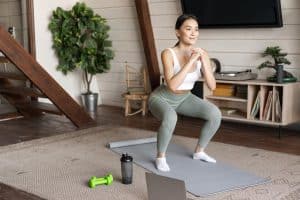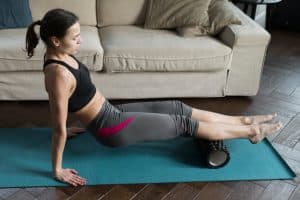10 No-Equipment Home Workouts That Transform Your Body in 30 Days

The Power of Training Without Equipment
One of the biggest myths in fitness is that you need expensive gear or a gym membership to see results. The truth? Bodyweight training turns your own body into the ultimate resistance tool. With simple movements like squats, push-ups, and planks, you can increase strength, burn calories, and build endurance—anytime, anywhere.
Getting Started: Laying the Groundwork for Success
Create Your Space
Set aside a small, clutter-free area where you can move freely. A yoga mat or towel adds comfort, and natural light or fresh air can boost energy. Keep water nearby to stay hydrated.
Set a Realistic Schedule
Pick times you’ll stick with—whether mornings before work or evenings after dinner. Use reminders, mark sessions on a calendar, and allow at least one rest day per week. Consistency matters more than intensity at the start.
Track Your Progress
Write down your reps, times, and energy levels. Snap progress photos or take measurements every week. Celebrating small wins—like doing extra push-ups or finishing an extra round—helps you stay motivated.
Workout 1: Full Body HIIT Circuit

Duration: 20 minutes
Format: 40 seconds work, 20 seconds rest, repeat 5 rounds
Exercises:
-
Squats
-
Push-ups (knee push-ups for beginners)
-
Reverse lunges
-
Mountain climbers
This circuit works multiple muscle groups and spikes your heart rate, delivering maximum results in minimum time. For advanced users, try jump squats or faster intervals. Always include a warm-up and cool-down.
👉 Reference: Harvard Health – The Benefits of Exercise
Workout 2: Lower Body Strength Builder

Duration: 15 minutes
Target: Legs and glutes
Exercises:
-
Bodyweight squats (controlled pace)
-
Reverse lunges
-
Lateral lunges
-
Calf raises
Do each for 40 seconds with 20 seconds rest, repeat 5 times. Beginners can shorten rounds, while advanced can add plyometric versions like jump squats. Strong legs boost metabolism, posture, and everyday stability.
Workout 3: Core Strength Sequence

Duration: 10 minutes
Exercises:
-
Plank – 30 sec
-
Side plank – 30 sec per side
-
Deadbug – 45 sec
-
Bicycle crunch – 45 sec
Repeat twice. A strong core supports posture, balance, and protects against back injury. For progression, extend holds or slow down movements.
Workout 4: Upper Body Sculpt
Duration: 15 minutes
Exercises:
-
Standard push-ups
-
Tricep dips (use sturdy chair)
-
Plank shoulder taps
-
Superman holds
-
Pike push-ups
Complete 3 rounds, 45 sec each. This tones chest, shoulders, arms, and back—key for upper body strength and mobility.
Workout 5: Tabata Metabolic Burn
Tabata compresses intensity into just 4 minutes: 20 seconds of max effort, 10 seconds rest, repeated 8 times.
Sample Round:
-
Burpees
-
High knees
-
Squat jumps
-
Mountain climbers
Alternate movements each round. This style ignites calorie burn and boosts endurance—even after the workout ends.
Workout 6: Flexibility & Mobility Routine

Duration: 15 minutes
Stretches:
-
Neck rolls & shoulder circles
-
Cat-cow for spine mobility
-
Hip flexor stretch
-
Seated hamstring stretch
-
Quad stretch
-
Figure-four stretch
-
Child’s pose
Hold each for 30–45 seconds. This improves range of motion, posture, and recovery—especially if you sit often.
Workout 7: Pyramid Challenge
Increase reps step-by-step, then work back down: 10 → 15 → 20 → 15 → 10.
Exercises:
-
Push-ups
-
Squats
-
Mountain climbers
-
Lunges
-
Plank shoulder taps
This structure builds muscular endurance and stamina through progressive overload, without needing weights.
Workout 8: Cardio Blast

Duration: 20 minutes
Dynamic warm-up (2 min), then alternate 40 sec work / 20 sec rest:
-
High knees
-
Squat jumps
-
Mountain climbers
-
Skater hops
-
Jumping jacks
Repeat 4 rounds. Modify by stepping instead of jumping for low-impact.
Workout 9: Isometric Strength Builder
Duration: 15 minutes
Exercises:
-
Plank hold – 1 min
-
Wall sit – 1 min
-
Glute bridge hold – 1 min
Repeat 4 times. Focus on breathing and proper form. Isometrics build stabilizer strength and endurance.
Workout 10: Total Body Integration

Duration: 25 minutes
Combine elements:
-
Squats into plank holds
-
Lunges into push-ups
-
Alternating dynamic + isometric holds
This final challenge blends everything you’ve learned—strength, stability, and endurance.
Creating Your 30-Day Workout Calendar
A 30-day schedule gives structure and accountability:
-
Beginners: 3 workout days + 2 active recovery days (walking, stretching)
-
Intermediate: 4–5 workout days, mixing HIIT, strength, and mobility
-
Advanced: 5–6 workout days with Tabata and pyramid sessions
Always include rest days for muscle recovery. Track workouts in a journal or app to monitor progress.
👉 Related: Smart Routines & Daily Habits
Nutrition Tips to Fuel Your Results
-
Balanced meals: Fill plates with lean protein, colorful vegetables, whole grains, and healthy fats.
-
Protein for repair: Eggs, Greek yogurt, chicken, beans. Supports muscle recovery.
-
Hydration: Aim for 2–3 liters daily. Helps reduce fatigue and optimize performance.
-
Pre-workout fuel: A banana with nut butter or small protein snack.
-
Post-workout recovery: Smoothie or sandwich with carbs + protein to restore glycogen and repair muscles.
👉 Reference: Mayo Clinic – Nutrition and Fitness
Tracking Progress Beyond the Scale
Fitness transformation isn’t only about pounds lost.
Track Your Fitness Transformation (Beyond the Scale)
Fitness transformation isn’t only about pounds lost. Use this checklist to track your non-scale victories each week.
Conclusion: Make Your Transformation Last
Completing 30 days of home workouts is an achievement—but the real win is consistency. To keep progressing:
-
Continue with 3–5 sessions per week
-
Gradually increase intensity with reps, sets, or shorter rests
-
Try new movement variations to prevent plateaus
Over time, the habit of moving regularly will give you not just a stronger body, but more energy, confidence, and long-term health.





